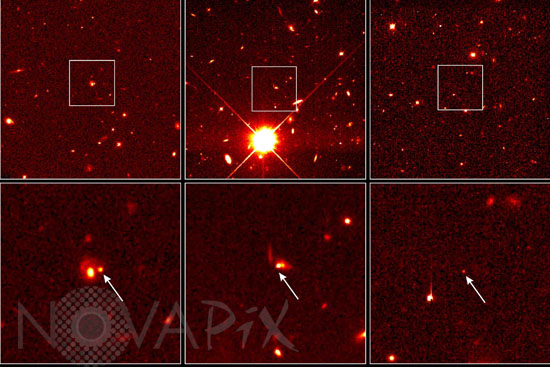Photo Agency - Astronomy - Space - Nature

Distant supernovae seen with Hubble space telescope
author: Nasa/Novapix
reference: a-snv90-00001
Image Size 300 DPI: 23 * 15 cm
These Hubble Space Telescope images pinpoint three distant supernovae, which exploded and died billions of years ago. Scientists are using these faraway light sources to estimate if the universe was expanding at a faster rate long ago and is now slowing down. Images of SN 1997cj are in the left hand column; SN 1997ce, in the middle; and SN 1997ck, on the right. All images were taken by the Hubble telescope's Wide Field and Planetary Camera 2. The top row of images are wider views of the supernovae. The supernovae were discovered in April 1997 in a ground-based survey at the Canada-France-Hawaii Telescope on Mauna Kea, Hawaii. Once the supernovae were discovered, the Hubble telescope was used to distinguish the supernovae from the light of their host galaxies. A series of Hubble telescope images were taken in May and June 1997 as the supernovae faded. Six Hubble telescope observations spanning five weeks were taken for each supernova. This time series enabled scientists to measure the brightness and create a light curve. Scientists then used the light curve to make an accurate estimate of the distances to the supernovae. Scientists combined the estimated distance with the measured velocity of the supernova's host galaxy to determine the expansion rate of the universe in the past (5 to 7 billion years ago) and compare it with the current rate. These supernovae belong to a class called Type Ia, which are considered reliable distance indicators. Looking at great distances also means looking back in time because of the finite velocity of light. SN 1997ck exploded when the universe was half its present age. It is the most distant supernova ever discovered (at a redshift of 0.97), erupting 7.7 billion years ago. The two other supernovae exploded about 5 billion years ago. SN 1997ce has a redshift of 0.44; SN 1997cj, 0.50. SN 1997ck is in the constellation Hercules, SN 1997ce is in Lynx, just north of Gemini; and SN 1997cj is in Ursa Major, near the Hubble Deep Field.
Keywords for this photo:
1997 - ASTRONOMY - EVOLUTION - HERCULES - HST - HUBBLE SPACE TELESCOPE - LYNX - SN 1997CE - SN 1997CJ - SN 1997CK - STAR - SUPERNOVA - TYPE Ia - URSA MAJOR -
Contact : Stéphane Aubin +33-(0)9-51-26-53-76
© Novapix - All rights reserved


